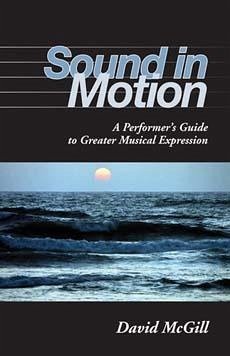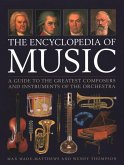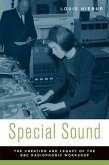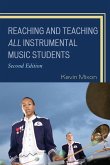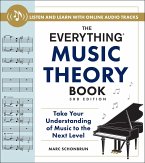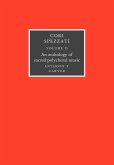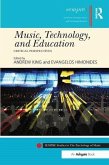27,99 €
inkl. MwSt.
Versandfertig in über 4 Wochen

14 °P sammeln
- Broschiertes Buch
- Merkliste
- Auf die Merkliste
- Bewerten Bewerten
- Teilen
- Produkt teilen
- Produkterinnerung
- Produkterinnerung
An insightful and imaginative study to deepen the performer's approach to music
Andere Kunden interessierten sich auch für
![The Encyclopedia of Music The Encyclopedia of Music]() Max Wade-MatthewsThe Encyclopedia of Music28,99 €
Max Wade-MatthewsThe Encyclopedia of Music28,99 €![Special Sound Special Sound]() Louis Niebur (Assistant Professor of Assistant Professor of MusicSpecial Sound39,99 €
Louis Niebur (Assistant Professor of Assistant Professor of MusicSpecial Sound39,99 €![Reaching and Teaching All Instrumental Music Students Reaching and Teaching All Instrumental Music Students]() Kevin MixonReaching and Teaching All Instrumental Music Students70,99 €
Kevin MixonReaching and Teaching All Instrumental Music Students70,99 €![The Everything Music Theory Book, 3rd Edition The Everything Music Theory Book, 3rd Edition]() Marc SchonbrunThe Everything Music Theory Book, 3rd Edition17,99 €
Marc SchonbrunThe Everything Music Theory Book, 3rd Edition17,99 €![Cori Spezzati Cori Spezzati]() Cori Spezzati45,99 €
Cori Spezzati45,99 €![Conducting a Choir Conducting a Choir]() Imogen HolstConducting a Choir40,99 €
Imogen HolstConducting a Choir40,99 €![Music, Technology, and Education Music, Technology, and Education]() Music, Technology, and Education41,99 €
Music, Technology, and Education41,99 €-
-
-
An insightful and imaginative study to deepen the performer's approach to music
Hinweis: Dieser Artikel kann nur an eine deutsche Lieferadresse ausgeliefert werden.
Hinweis: Dieser Artikel kann nur an eine deutsche Lieferadresse ausgeliefert werden.
Produktdetails
- Produktdetails
- Verlag: Indiana University Press
- Seitenzahl: 392
- Erscheinungstermin: 17. März 2009
- Englisch
- Abmessung: 235mm x 161mm x 28mm
- Gewicht: 586g
- ISBN-13: 9780253219268
- ISBN-10: 0253219264
- Artikelnr.: 22942724
- Herstellerkennzeichnung
- Libri GmbH
- Europaallee 1
- 36244 Bad Hersfeld
- gpsr@libri.de
- Verlag: Indiana University Press
- Seitenzahl: 392
- Erscheinungstermin: 17. März 2009
- Englisch
- Abmessung: 235mm x 161mm x 28mm
- Gewicht: 586g
- ISBN-13: 9780253219268
- ISBN-10: 0253219264
- Artikelnr.: 22942724
- Herstellerkennzeichnung
- Libri GmbH
- Europaallee 1
- 36244 Bad Hersfeld
- gpsr@libri.de
Grammy winning bassoonist, David McGill, has served as principal bassoon of the Chicago Symphony Orchestra since 1997. He has also served as principal of the Cleveland Orchestra, the Toronto Symphony, and the Tulsa Philharmonic. A graduate of the Curtis Institute of Music in Philadelphia (1985), he has taught at DePaul and Roosevelt Universities in Chicago, Indiana University, the Cleveland Institute of Music, and the University of Toronto. He has given master classes in Finland, Hungary, and across the United States and Canada.
Contents
Preface
Acknowledgments
Part 1. A Style Is Born
Part 2. What Is Music?
Fun?
Magic?
Feeling?
Talent?
Selflessness?
Professionalism
Motion
Part 3. Note Grouping
Sound Writing (?)
What Is Note Grouping?
Basic Grouping
Harmonic Grouping
Rhythmic Grouping
Motivic Grouping
Range and Scaling
The Tabuteau Number System
Why Does Grouping Sound Natural?
Part 4. The Larger Picture
Sound Connection
Type and Function
Skeletal Structure
What Is Phrasing?
Repetition
What Is Line?
The Four Elements of Music
Part 5. Wind Techniques
Breathing
The Long Tone
The Singing Interval
The Fingers
Scales
Using the Wind
Articulation
Part 6. Controversy
Tone
Intonation
Vibrato
Ornaments
Was There a Baroque Style of Playing?
Music Speaks
Portato: Herald of a New Romanticism
"Technique" vs. "Musicality"
Part 7. The Profession
Practicing
Auditioning
Orchestral Protocol
Performing
Accompanying
Teaching
Part 8. The Search
Postscript
Appendix 1. Recommended Recordings
Appendix 2. Further Study
Appendix 3. To Clip or Not to Clip
Notes
Bibliography
Index
About the Author
Preface
Acknowledgments
Part 1. A Style Is Born
Part 2. What Is Music?
Fun?
Magic?
Feeling?
Talent?
Selflessness?
Professionalism
Motion
Part 3. Note Grouping
Sound Writing (?)
What Is Note Grouping?
Basic Grouping
Harmonic Grouping
Rhythmic Grouping
Motivic Grouping
Range and Scaling
The Tabuteau Number System
Why Does Grouping Sound Natural?
Part 4. The Larger Picture
Sound Connection
Type and Function
Skeletal Structure
What Is Phrasing?
Repetition
What Is Line?
The Four Elements of Music
Part 5. Wind Techniques
Breathing
The Long Tone
The Singing Interval
The Fingers
Scales
Using the Wind
Articulation
Part 6. Controversy
Tone
Intonation
Vibrato
Ornaments
Was There a Baroque Style of Playing?
Music Speaks
Portato: Herald of a New Romanticism
"Technique" vs. "Musicality"
Part 7. The Profession
Practicing
Auditioning
Orchestral Protocol
Performing
Accompanying
Teaching
Part 8. The Search
Postscript
Appendix 1. Recommended Recordings
Appendix 2. Further Study
Appendix 3. To Clip or Not to Clip
Notes
Bibliography
Index
About the Author
Contents
Preface
Acknowledgments
Part 1. A Style Is Born
Part 2. What Is Music?
Fun?
Magic?
Feeling?
Talent?
Selflessness?
Professionalism
Motion
Part 3. Note Grouping
Sound Writing (?)
What Is Note Grouping?
Basic Grouping
Harmonic Grouping
Rhythmic Grouping
Motivic Grouping
Range and Scaling
The Tabuteau Number System
Why Does Grouping Sound Natural?
Part 4. The Larger Picture
Sound Connection
Type and Function
Skeletal Structure
What Is Phrasing?
Repetition
What Is Line?
The Four Elements of Music
Part 5. Wind Techniques
Breathing
The Long Tone
The Singing Interval
The Fingers
Scales
Using the Wind
Articulation
Part 6. Controversy
Tone
Intonation
Vibrato
Ornaments
Was There a Baroque Style of Playing?
Music Speaks
Portato: Herald of a New Romanticism
"Technique" vs. "Musicality"
Part 7. The Profession
Practicing
Auditioning
Orchestral Protocol
Performing
Accompanying
Teaching
Part 8. The Search
Postscript
Appendix 1. Recommended Recordings
Appendix 2. Further Study
Appendix 3. To Clip or Not to Clip
Notes
Bibliography
Index
About the Author
Preface
Acknowledgments
Part 1. A Style Is Born
Part 2. What Is Music?
Fun?
Magic?
Feeling?
Talent?
Selflessness?
Professionalism
Motion
Part 3. Note Grouping
Sound Writing (?)
What Is Note Grouping?
Basic Grouping
Harmonic Grouping
Rhythmic Grouping
Motivic Grouping
Range and Scaling
The Tabuteau Number System
Why Does Grouping Sound Natural?
Part 4. The Larger Picture
Sound Connection
Type and Function
Skeletal Structure
What Is Phrasing?
Repetition
What Is Line?
The Four Elements of Music
Part 5. Wind Techniques
Breathing
The Long Tone
The Singing Interval
The Fingers
Scales
Using the Wind
Articulation
Part 6. Controversy
Tone
Intonation
Vibrato
Ornaments
Was There a Baroque Style of Playing?
Music Speaks
Portato: Herald of a New Romanticism
"Technique" vs. "Musicality"
Part 7. The Profession
Practicing
Auditioning
Orchestral Protocol
Performing
Accompanying
Teaching
Part 8. The Search
Postscript
Appendix 1. Recommended Recordings
Appendix 2. Further Study
Appendix 3. To Clip or Not to Clip
Notes
Bibliography
Index
About the Author
